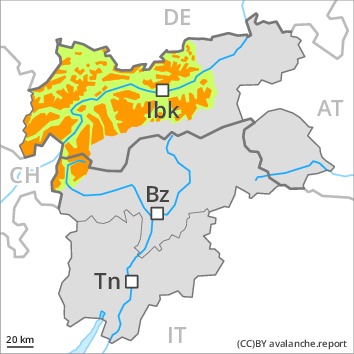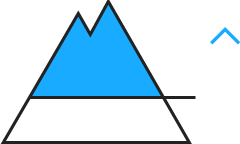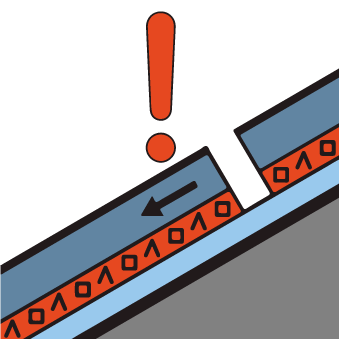
Danger level
 | treeline
|
Avalanche Problem
 | | Wind-drifted snow |
|  | |  |
 | | Persistent weak layer |
|  | |  |

Wind slabs are to be evaluated critically.
As a consequence of a strong wind from variable directions, sometimes avalanche prone wind slabs will form in all aspects, caution is to be exercised in particular adjacent to ridgelines and in gullies and bowls. These can be released by a single winter sport participant. Mostly the avalanches are rather small. The number and size of avalanche prone locations will increase with altitude.
Weak layers in the lower part of the snowpack can still be released in isolated cases by individual winter sport participants. Caution is to be exercised in particular on steep shady slopes above approximately 2200 m, especially in areas where the snow cover is rather shallow, as well as at transitions from a shallow to a deep snowpack, when entering gullies and bowls for example.
Snowpack
dp.6: cold, loose snow and wind
dp.1: deep persistent weak layer
Over a wide area 10 cm of snow, and even more in some localities, will fall. The strong wind will transport the fresh and old snow. In some places wind slabs are lying on surface hoar.
Steep shady slopes: The old snowpack will be prone to triggering in some places. Towards its base, the snowpack is faceted and weak. Whumpfing sounds and the formation of shooting cracks when stepping on the snowpack are a clear indication of a weakly bonded snowpack.
Tendency
The avalanche danger will increase but remain within the current danger level.

Danger level
 | treeline
|
Avalanche Problem

Wind slabs are to be evaluated critically.
Fresh and somewhat older wind slabs can be released by a single winter sport participant in all aspects above the tree line. Caution is to be exercised in particular adjacent to ridgelines and in gullies and bowls. Mostly the avalanches are only small. The prevalence of avalanche prone locations and likelihood of triggering will increase with altitude.
On steep sunny slopes only isolated gliding avalanches are possible.
Snowpack
dp.6: cold, loose snow and wind
In some regions up to 10 cm of snow, and even more in some localities, will fall. As a consequence of a strong wind from variable directions, avalanche prone wind slabs will form. In some places wind slabs are lying on surface hoar, especially on shady slopes. In its middle, the snowpack is well consolidated. Towards its base, the snowpack is faceted, especially on shady slopes above the tree line, as well as in all aspects in high Alpine regions.
Tendency
The avalanche danger will increase but remain within the current danger level.

Danger level
 | treeline
|
Avalanche Problem

Wind slabs require caution.
The fresh wind slabs are in some cases prone to triggering above the tree line, especially on steep shady slopes. Mostly avalanches are only small but can be released also by a single winter sport participant. The prevalence of avalanche prone locations and likelihood of triggering will increase with altitude.
Snowpack
dp.6: cold, loose snow and wind
As a consequence of new snow and a strong wind from variable directions, mostly small wind slabs will form above the tree line. In some places wind slabs are lying on surface hoar, especially on shady slopes.
Tendency
Increase in danger of dry avalanches as a consequence of new snow and wind.

Danger level
 | treeline
|
Avalanche Problem

Wind slabs require caution.
The fresh and somewhat older wind slabs are prone to triggering in all aspects above the tree line. Mostly avalanches are rather small but can be released even by a single winter sport participant. The prevalence of avalanche prone locations and likelihood of triggering will increase with altitude. In regions neighbouring those that are subject to danger level 3 (considerable) the avalanche prone locations are more prevalent and the danger is greater.
On steep sunny slopes only isolated gliding avalanches are possible.
Snowpack
dp.6: cold, loose snow and wind
Over a wide area 5 cm of snow, and even more in some localities, will fall. As a consequence of new snow and a strong wind from variable directions, mostly small wind slabs will form above the tree line. In some places wind slabs are lying on surface hoar, especially on shady slopes. In its middle, the snowpack is well consolidated. Towards its base, the snowpack is faceted, especially on shady slopes above the tree line, as well as in all aspects in high Alpine regions.
Tendency
Slight increase in danger of dry avalanches as a consequence of the strong northerly wind.












